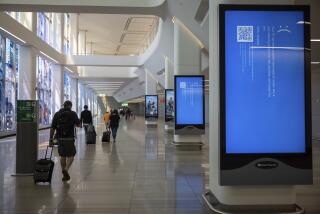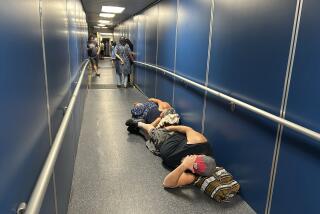From Offices to Entertainment, an Unnerved Nation Closes Down
Much of America shut down.
From the White House and virtually every other federal building in the country, to Seattle’s Space Needle to Hoover Dam near Las Vegas and the Walt Disney amusement parks in Orlando, Fla., government centers, office buildings and tourist attractions all closed Tuesday because they were possible terrorism targets.
There was no major league baseball, no stock market.
Shopping malls in the Midwest, law offices in the South, banks in the West, oil company headquarters in Houston and car manufacturers in Michigan. All closed.
Beyond just the shut airports, transit was crippled: Police in Houston closed a section of freeway after a truck traveling the wrong direction and suspected of carrying explosives was stopped--only to find it was carrying furniture. Most ferries in Washington state were closed to vehicular traffic, for fear of car bombs. Greyhound and Amtrak suspended all service in the Northeast; the U.S. section of the St. Lawrence Seaway was closed, and the tunnel between Detroit and Windsor, Canada, was closed to traffic. Car rental agencies near airports were deluged.
It was as if a wholly unnerved America, frozen in the headlights, braced for what might happen next and went home--for safety and to watch television, or to blood donation centers, or to churches.
State government offices that remained opened for public business--as was the case in Nevada and Oklahoma--were the exception, not the rule. In Boston, Massachusetts Acting Gov. Jane M. Swift retreated to an emergency command bunker. In Atlanta, the Georgia General Assembly stood and sang “God Bless America” before leaving the building.
Workers poured out of the nation’s tallest office buildings as commerce ground to a halt--from the 110-story Sears Tower and 100-story John Hancock Center in Chicago to Boston’s Prudential Center, John Hancock Tower and International Place, to the IDS Center in Minneapolis and the World Trade Center in St. Paul, to the Peachtree Center in Atlanta and the Bank of America Tower in Seattle.
In Florida, where President Bush was visiting when the calamity unfolded, closures swept from the state’s parks, libraries and shopping malls to its 11 universities.
The president’s brother, Gov. Jeb Bush, declared a state of emergency and ordered the evacuation of the high-rise Capitol building “to ensure that we are prepared for any eventuality.”
The Kennedy Space Center was placed under a “Threatcon Delta” condition, the highest of four states of emergency. Buildings were locked, tourists turned away and security patrols beefed up while 12,000 workers were sent home.
“We’ve had no indication of an imminent threat to the Kennedy Space Center,” NASA spokesman Joel Wells said. “But we are taking these incidents very seriously.”
High above, the commander of the international space station, Frank Culbertson, reported he could see the smoke hovering over Manhattan.
The nation’s largest shopping malls--from the Mall of America in Minneapolis to Lenox Square mall in Atlanta--were closed. Even in malls that remained opened, stores with New York headquarters closed individually. Seattle-based Starbucks Corp. also shut its 2,900 stores nationwide.
Elsewhere in Atlanta, employees were sent home from the Centers for Disease Control and Prevention and from Coca-Cola’s international headquarters.
Extra elevated and commuter trains were dispatched into downtown Chicago to help workers make their way home, even as police guarded entrances to the maze of subterranean streets and tunnels in the city’s financial district, the Loop.
Authorities in Chicago barricaded the entrances to power plants and pumping facilities with concrete blocks and heavy trucks, and many of the city’s main tourist attractions were closed, including the Art Institute, the Field Museum and the Shedd Aquarium.
Officials in Oklahoma City closed downtown streets, creating such gridlock that workers were advised they may not reach home until after nightfall.
The performing arts were stricken too. In Washington, the Kennedy Center and the Arena Stage canceled performances, and in New York, the Lincoln Center was evacuated after canceling all performances. Broadway theaters and shows closed for the day.
Also in New York, the remaining four days of a week of spring preview fashion shows were canceled.
In Las Vegas, the 1,149-foot Stratosphere Tower--the tallest building west of the Mississippi--was closed, as was the half-scale Eiffel Tower in the middle of the Strip.
The Strip’s hotels announced the cancellation of evening shows. Other tourism attractions were canceled as well, including the Bellagio’s elaborate dancing fountains, the Mirage’s volcano and Treasure Island’s pirate battle.
“We’ve chosen to postpone anything that’s not essential,” said MGM Mirage spokesman Alan Feldman. “There’s simply no need to do these things today.”
The Las Vegas Convention Center was evacuated after someone called in a bomb threat from a pay phone within the building. A search uncovered nothing, but the opening of the International Baking Industry Expo, with 30,000 participants, was delayed by one day.
The break in America’s business even rippled to the Texas death chamber, where an execution planned for Tuesday night was stayed for 30 days because the Texas Supreme Court had closed, precluding any possible last-minute appeals.
Times staff writers John-Thor Dahlburg in Miami, Elizabeth Mehren in Boston, Eric Slater in Chicago, E. Scott Reckard in Orange County and Valli Herman-Cohen in Los Angeles contributed to this story. Also contributing were Times researchers John Beckham in Washington, Lianne Hart in Houston, Lynn Marshall in Seattle, Belen Rodriguez in Denver, Edith Stanley in Atlanta, and Anna M. Virtue in Miami.
More to Read
Sign up for Essential California
The most important California stories and recommendations in your inbox every morning.
You may occasionally receive promotional content from the Los Angeles Times.










